The movie opens with the testing of a new nuclear-powered submarine which has its maneuvers interrupted by a massive sonar contact, a contact that starts pursuing the sub and it’s up Commander Pete Mathews (Kenneth Tobey ) to save his crew from this mysterious foe. Once the submarine is able to escape the grip of this unknown force, which caused some damage to the sub’s diving planes, they return to Pearl Harbour to discover a surprisingly large chunk tissue jammed into the mechanism. A co-ed team of marine biologists, Professor Lesley Joyce (Faith Domergue ) and John Carter (Donald Curtis ) of Harvard University are called in to identify the tissue, but the United States Navy isn’t all that thrilled that after four weeks of testing their conclusion they come up with is that the tissue is that of a giant octopus.
“A rampaging dinosaur is one thing but a giant octopus is just silly.”
What is interesting about It Came from Beneath the Sea is that unlike the giant ants in Them the radiation from the atomic testing isn’t directly blamed for the existence of a giant octopus but that of the hydrogen bomb which has made the already giant creature radioactive. This resulted in its natural food supply being driven away, other fish being able to sense the radiation and flee, thus forcing the octopus to leave it’s natural habitat deep within the Philippine Trench to look for a new source of food.After their findings are ignored Joyce and Carter were to be released from duty – a duty they were basically conscripted by the Navy to perform – and return to their regular scheduled academic lives, unfortunately, a few more nautical mishaps occur which has the Navy re-thinking that they may have been a trifle too hasty dismissing the findings of the two eggheads.
Budget Note: Ray Harryhausen purchased the model used for the Tramp Steamer that is sunk by the giant octopus from a Five and Dime store.
The very feel of It Came from Beneath the Sea is that of a documentary, with narration and exposition doing its best to make the idea of a giant octopus seeming like a credible threat, but another more insidious threat that rears its ugly head in this film would be the rampant male chauvinism. The character of Commander Pete Mathews is most definitely a product of the times – he wouldn’t survive ten minutes in the "Me Too" movement – but strangely enough, the screenplay has him facing off against a quite modern woman. Professor Lesley Joyce is not your typical damsel in distress as she is a capable and career-driven woman and it’s her work that leads to defeating the monster. She is a woman of science, independent of the men around her, and yet this film has her falling in love with a guy who sees nothing wrong with dragging a woman onto the dance floor and kissing her against her will. Worse is the fact that after two minutes of said dancing and lip mashing he assumes that she is going to cancel her planned scientific excursion to Egypt with Carter so that she can settle down with him and start knitting baby booties. When he is shot down he has the nerve to turn to Carter and offer this wonderful bon mot, “Do you mind if I make a mental comment upon the nature of women?”
Where’s a giant octopus when you need one?
Luckily for us, this budding romance is put on hold when that tramp steamer is sunk by "our hero" the giant octopus and the trio are then sent to investigate various other possible instances of cephalopod attacks. What follows is your standard B movie monster formula with our leads running about gathering information, newscaster reporting on the ever-increasing threat, and lots of stock footage of the military doing military type stuff, but through all that I’m still left with a big question “Why Commander Pete Mathews is involved at all with any of this?” Sure, he was the first person to encounter the creature but after filing his initial report that should have been the end of it, yet for some reason he’s given the job of babysitting Joyce and Carter while they try and figure out what attacked his sub. This is not the kind of position you’d think a commander of a nuclear submarine would be saddled with. All they needed was some ensign to answer the phone and say “They haven’t it figured out yet” but instead the United States Navy has Commander Pete Mathews sitting on his ass for bloody four weeks, doing nothing except hitting on Joyce. I could see his character being brought in at the end when they needed a submarine to shoot the octopus but his inclusion in the bulk of this film ranges from the awkward to cringe-inducing. Thank god the giant octopus finally goes on a decent rampage and we can forget about good ole Pete for a while.Budget Note: Due to budgetary restraints the giant octopus in this film has six arms, not the normal eight. Harryhausen posed the creature so this lack of the right number of arms wasn't apparent.
Of course, it’s this monstrous rampage that audiences have paid their two bits to see and Ray Harryhausen doesn’t disappoint – love triangles and sexism were just there to pad the running time between monster appearances – and when the beast rises out of the depth we get some spectacular examples of Harryhausen’s trademark Dynamation technique. It was a viewing of The Beast from 20,000 Fathoms that inspired producer Charles Schneer to call Ray Harryhausen with the idea of a giant octopus destroying pulling down the Golden Gate Bridge – which started a partnership that lasted twenty-six years – and the film doesn’t stint on that premise, we definitely get to see this massive sea monster wrap its massive arms around this now iconic landmark.
Production Note: City officials refused the production access to the bridge for filming because they feared a movie featuring a giant octopus tearing down the Golden Gate Bridge would cause the public to lose faith in the bridge’s stability. This did not stop Harryhausen and friends as they proceeded to take background plates by shooting out of the back of a bakery truck which they drove back and forth across the bridge.
An obvious stumbling block when dealing with a title creature that resides in the sea is in figuring out its threat level, because though a sea monster is an awesome menace it does cause one to wonder, “How can it be a threat to anything other than people on boats?” It Came from Beneath the Sea tackles this problem by utilizing the beast’s immensely long arms as it reaches out of the sea to snag its prey, whether they be inside a building or fleeing uselessly down a city street. Seeing the giant octopus tear down the Embarcadero and break into the Ferry Building gave viewers some of the best “Monsters Unleashed” moments in cinema history, and it was the proceeding sixty minutes of “Newsreel” type seriousness that really helped sell the ludicrousness of the last act.
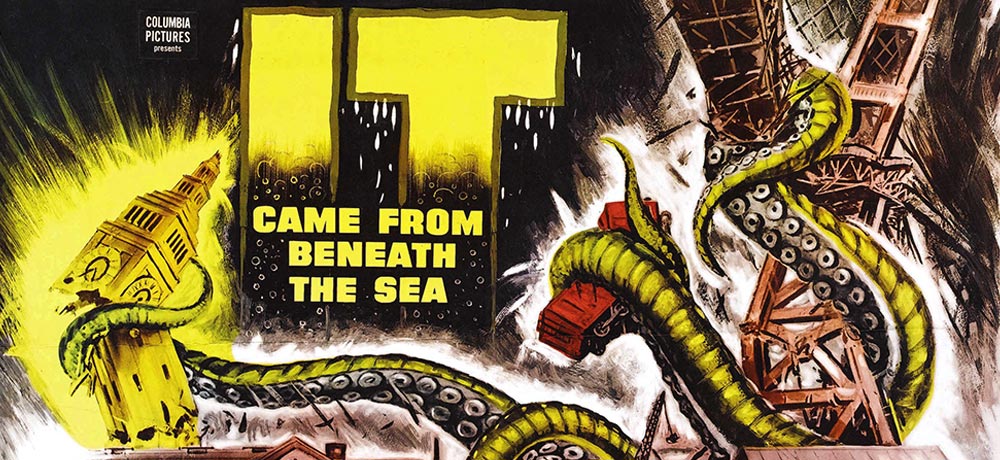
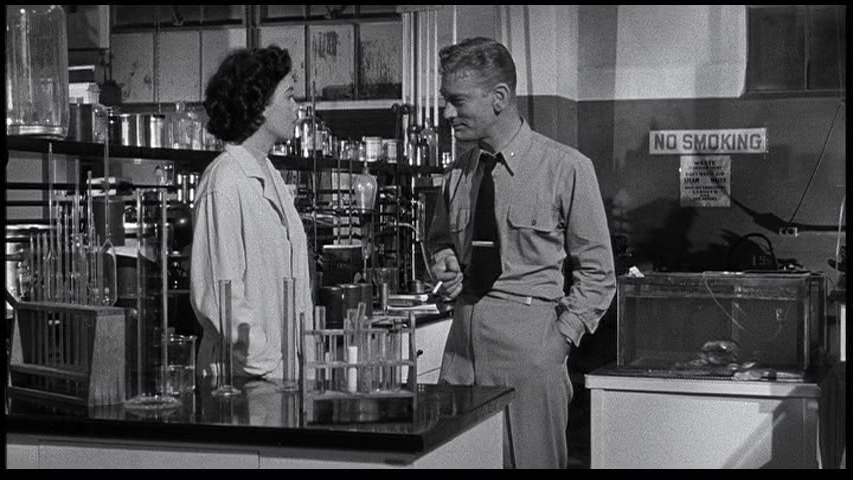
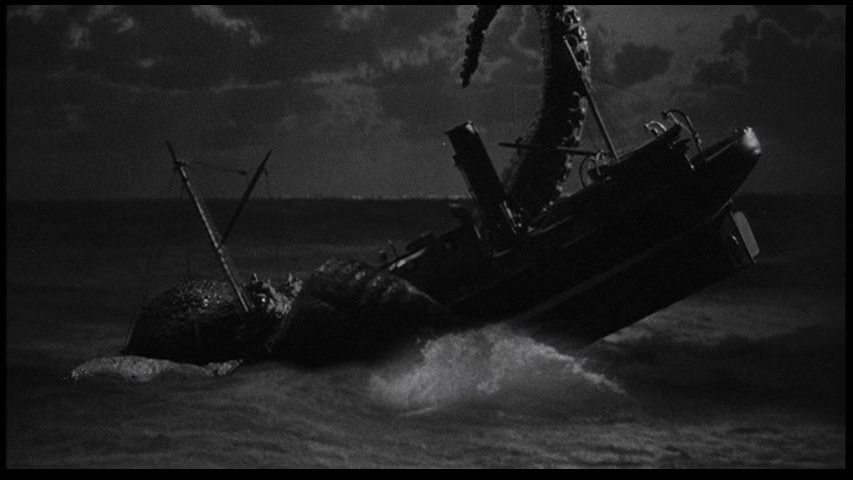
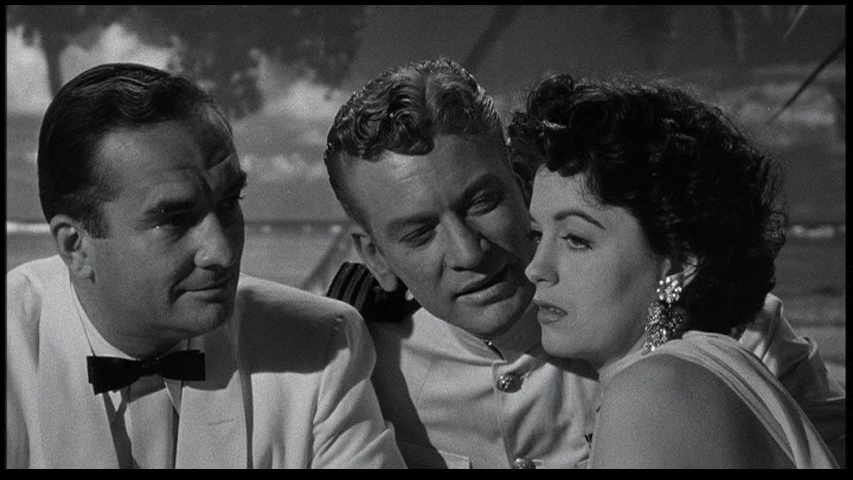
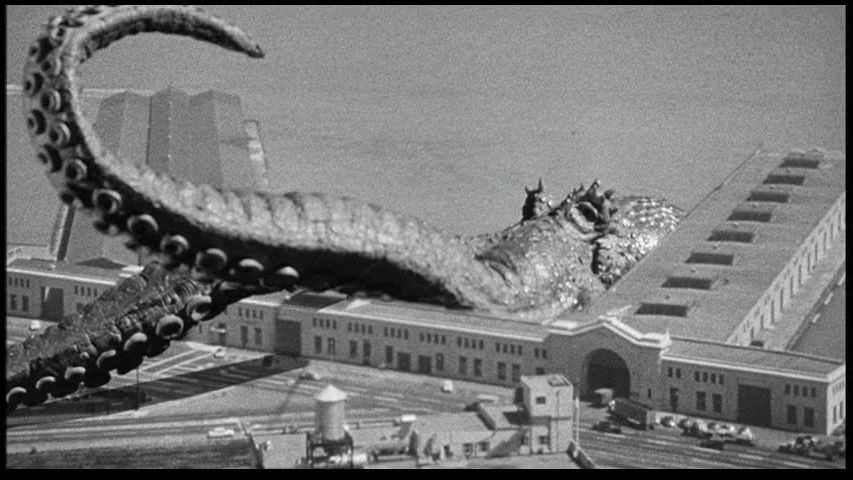
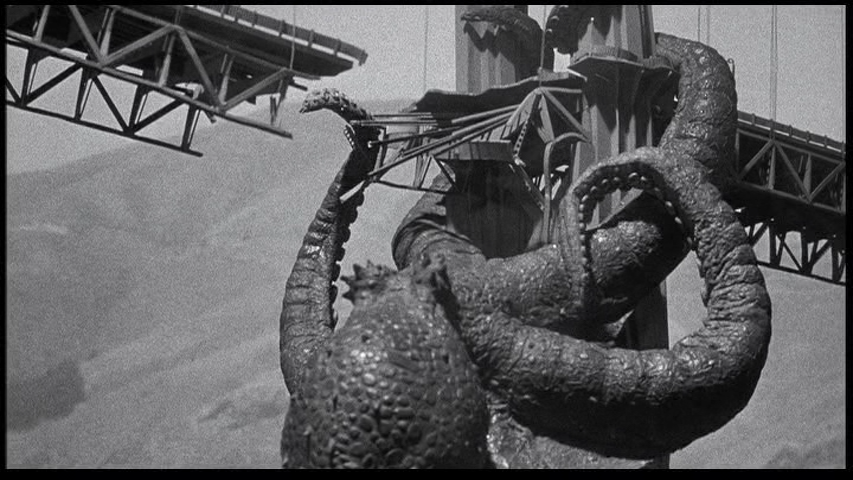
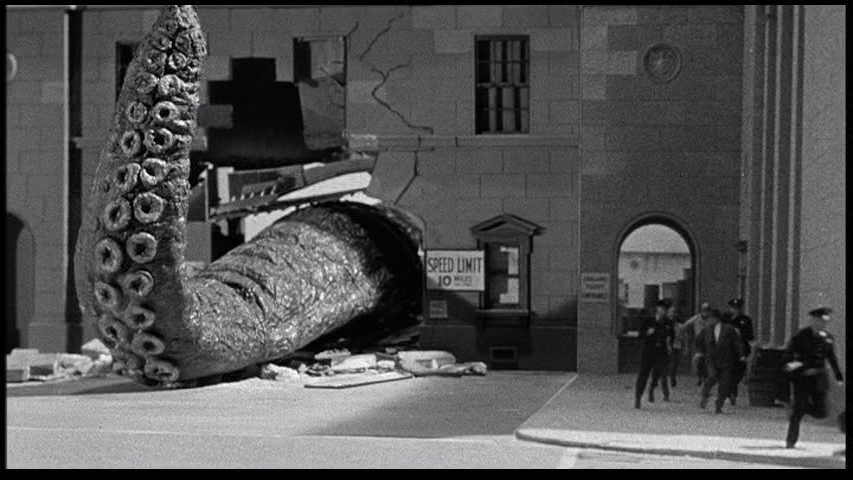
No comments:
Post a Comment